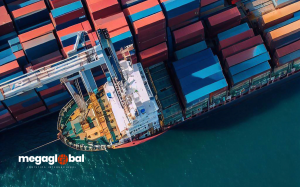Shanghai-Santos Route: Factors Driving Maritime Freight Rate Increases
Understand how cargo demand and ship shortages affect global logistics costs.
According to a recent article published by Mundo Marítimo, spot rates on the Shanghai-Santos maritime route have reached unprecedented levels, making it the most expensive route from the Chinese port in terms of revenue per nautical mile.
The maritime transport sector has faced significant fluctuations in recent years, with spot rates on some trade routes reaching record levels. One of the most affected routes is Shanghai-Santos, where shipping prices have skyrocketed. But what is driving this phenomenon? In this article, we will explore the factors behind these increases and how they can affect companies involved in international trade.
Rising Cargo Demand
One of the key factors driving the rise in rates on the Shanghai-Santos route is the growing demand for cargo, especially from China, one of the world’s largest exporters. Emerging economies like Brazil are importing more goods, putting more pressure on shipping capacities. Furthermore, with the post-pandemic economic recovery in progress, companies have increased their import levels to restock inventories, contributing to the route’s saturation.
Ship Shortages and Limited Space
A critical factor driving prices up is the shortage of available ships. The global demand surge has not been matched by an equivalent expansion in the maritime fleet. This is partly due to delays in new ship construction and operational disruptions caused by environmental and health regulations. As a result, shipping lines prioritize cargo with higher spot rates, raising costs for logistics managers looking for available space for their goods.
Direct Impact on Logistics Costs
The rise in maritime transport rates directly impacts the operational costs of companies relying on international trade. Companies importing products from China to Brazil, or vice versa, are seeing their logistics costs skyrocket, which can, in turn, affect the final prices of goods for consumers. In many cases, these companies are forced to pass on these increases to sales prices, which can reduce their competitiveness in the market.
Alternatives and Strategies for Logistics Managers
In this scenario, logistics managers must find solutions to mitigate the impact of rising rates. Some strategies include:
– Negotiate long-term contracts: Signing long-term agreements with shipping lines can help avoid spot rate volatility and secure consistent space on ships.
– Optimize shipment planning: Advance planning allows better pricing and avoids higher rates caused by urgency.
– Explore alternative routes: Although rates on the Shanghai-Santos route are high, exploring other ports or longer routes may result in lower costs.
Future Prospects
While it’s difficult to predict exactly how maritime transport rates will evolve, most experts believe the current situation could persist into the next year, with slight relief as ship supply stabilizes. The digitization of the sector and improvements in logistics technologies could also offer new opportunities to face these challenges.
Are you ready to optimize your logistics strategy amid market fluctuations? Stay updated on the latest trends in maritime transport to make informed decisions. Subscribe to our blog for practical advice on improving your logistics management.
#MaritimeTransport #ShanghaiSantos #SupplyChains #FreightRates #LogisticsManagement #InternationalTrade #SmartLogistics #CargoDemand #ShipShortage







